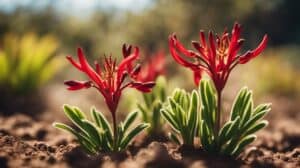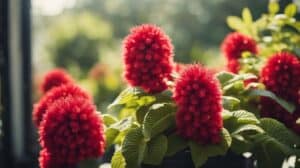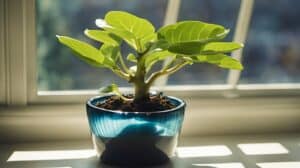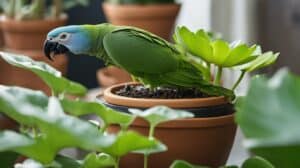Palm trees are a popular addition to any indoor space, adding a tropical and relaxing vibe to the environment.
However, growing palm trees indoors can be a challenge, especially when it comes to propagation.
In this article, we will explore techniques for growing two popular indoor palm tree varieties: Areca and Majesty palms.

Areca palms, also known as butterfly palms, are native to Madagascar and are a popular choice for indoor spaces due to their attractive feathery fronds and ability to purify the air.
Majesty palms, on the other hand, are native to Madagascar and the surrounding islands, and are known for their graceful, arching fronds and elegant appearance.
While both palm varieties are relatively easy to care for, propagation can be a bit tricky without the right techniques.
Whether you’re a seasoned indoor gardener or just starting out, learning the proper techniques for propagating Areca and Majesty palms can help you grow healthy, beautiful plants that will thrive in your indoor space.
In the following sections, we will explore the steps necessary to propagate these two popular palm tree varieties and provide tips for ensuring their success.
Basics of Palm Tree Propagation
Palm trees are a popular choice for indoor plants due to their tropical appearance and low maintenance requirements.
Propagating palm trees is a great way to expand your collection.
In this section, we will discuss the basics of palm tree propagation, including understanding palm seed germination and propagation through division.
Understanding Palm Seed Germination
Palm trees can be propagated through seeds, but they can be challenging to germinate.
It is essential to use fresh seeds and ensure that the soil is moist but not waterlogged.
The seeds should be planted in a well-draining soil mixture and kept in a warm, humid environment.
Once the seeds have been planted, it can take several weeks or even months for them to germinate.
It is essential to be patient and provide the seeds with the right conditions for germination.
Propagation Through Division
Propagation through division is a more straightforward method of propagating palm trees.
This method involves dividing the plant into smaller sections and replanting them in new pots.
This technique works best for palm trees that have multiple stems or offshoots.
To propagate through division, gently remove the plant from its pot and separate the offshoots from the main plant.
Be sure to use sharp, clean scissors or pruning shears to avoid damaging the plant.
Once you have separated the offshoots, plant them in fresh soil in their own pots.
In conclusion, understanding the basics of palm tree propagation is essential for growing healthy and robust plants.
Whether you choose to propagate through seeds or division, it is essential to provide the right conditions and take care not to damage the plant during the process.
With a little patience and care, you can enjoy beautiful, thriving palm trees in your home.
Areca Palm Propagation

Seed Sowing Technique for Areca Palms
Areca palms are propagated through seeds. The seeds are found inside the fruit of the palm tree.
To obtain the seeds, one should wait for the fruit to ripen and turn yellow. Once the fruit is ripe, it can be harvested and the seeds can be extracted.
After extracting the seeds, they should be soaked in warm water for 24 hours to soften the outer shell.
Once the shell is soft, it can be removed by gently rubbing the seed with a cloth.
Next, fill a pot with a well-draining potting mix and plant the seeds about 1 inch deep. Water the potting mix until it is moist but not waterlogged.
Cover the pot with a plastic wrap to create a greenhouse effect and place it in a warm and bright location.
Caring for Areca Palm Seedlings
Areca palm seedlings require warm temperatures and high humidity to grow.
The ideal temperature range is between 70-85°F (21-29°C) and the humidity should be around 60-70%.
To maintain the required humidity, mist the seedlings regularly with a spray bottle.
Water the seedlings when the top inch of the potting mix feels dry to the touch.
Once the seedlings have grown to about 6 inches tall, they can be transplanted into larger pots.
Use a well-draining potting mix and ensure that the pot has drainage holes to prevent waterlogging.
In conclusion, Areca palm propagation can be done easily through seed sowing.
With the right care and environment, the seedlings can grow into beautiful palm trees that can add a tropical touch to any indoor space.
Majesty Palm Propagation

Majesty palms are popular indoor plants due to their beautiful fronds and tropical appearance.
Propagating Majesty palms is relatively easy and can be done using two methods: cuttings and offshoots.
Optimal Conditions for Majesty Palm Cuttings
To propagate Majesty palms using cuttings, it is important to select a healthy stem that is at least 6 inches long and has a few leaves attached.
The cutting should be taken from the base of the plant and should be allowed to dry for a few days before planting.
Once the cutting has dried, it can be planted in a well-draining soil mix and placed in a warm, humid location.
The soil should be kept moist but not waterlogged, and the cutting should be misted regularly to maintain humidity.
Rooting Majesty Palm Offshoots
Majesty palms also produce offshoots, which can be removed and planted to propagate new plants.
To remove an offshoot, gently dig around the base of the plant and locate the offshoot.
Carefully cut the offshoot from the parent plant, making sure to leave some of the roots attached.
The offshoot should be planted in a well-draining soil mix and placed in a warm, humid location.
The soil should be kept moist but not waterlogged, and the offshoot should be misted regularly to maintain humidity.
Overall, propagating Majesty palms is a simple process that can be done using either cuttings or offshoots.
With the right conditions and care, new plants can be easily grown and enjoyed in any indoor space.
Indoor Cultivation Tips

Soil and Potting Mixtures
When growing Areca and Majesty palms indoors, it is important to choose the right soil and potting mixture.
These plants prefer well-draining soil that is rich in organic matter. A good potting mix should contain peat moss, perlite, and vermiculite.
It is also important to ensure that the pot has drainage holes to prevent water from accumulating in the soil.
Light and Temperature Requirements
Areca and Majesty palms require bright, indirect light to thrive indoors.
They should be placed near a window that receives plenty of sunlight, but not in direct sunlight as this can scorch their leaves.
These plants also prefer warm temperatures between 65-85°F.
It is important to avoid placing them near cold drafts or air conditioning vents as this can cause damage to the leaves.
Watering and Fertilization Practices
Proper watering and fertilization practices are essential for the health of Areca and Majesty palms.
These plants should be watered regularly, but not overwatered as this can lead to root rot.
It is best to allow the top inch of soil to dry out before watering again.
Fertilizer should be applied every 2-3 months during the growing season using a balanced fertilizer.
It is important to follow the instructions on the fertilizer package and not to over-fertilize as this can damage the plant.
Overall, with the right soil, light, temperature, watering, and fertilization practices, Areca and Majesty palms can thrive indoors and add a touch of tropical beauty to any home.
Frequently Asked Questions

What is the best method to propagate an areca palm indoors?
The best method to propagate an areca palm indoors is through division.
This involves separating the plant into smaller sections and replanting them in fresh soil.
It is important to ensure that each section has enough roots and foliage to survive on its own.
Can you root a palm cutting in water, and how?
Yes, you can root a palm cutting in water. Start by taking a cutting from the parent plant, making sure it has at least one node.
Remove any leaves from the lower part of the cutting and place it in a container filled with water.
Change the water every few days and wait for roots to appear before planting the cutting in soil.
What steps are involved in growing an areca palm from seeds?
To grow an areca palm from seeds, start by soaking the seeds in warm water for 24 hours to soften the outer shell.
Plant the seeds in a well-draining soil mixture and keep the soil moist but not waterlogged.
Place the pot in a warm and bright area, and wait for the seeds to germinate, which can take up to several months.
How can I encourage my areca palm to grow more quickly and become bushier?
To encourage an areca palm to grow more quickly and become bushier, provide it with bright, indirect light and keep the soil moist but not waterlogged.
Fertilize the plant every few months with a balanced fertilizer, and prune any dead or yellowing fronds to promote new growth.
What are the ideal conditions for rooting an indoor palm tree?
The ideal conditions for rooting an indoor palm tree include a warm and humid environment, well-draining soil, and bright, indirect light.
It is also important to keep the soil moist but not waterlogged, and to avoid exposing the plant to cold drafts or direct sunlight.
How should I care for my indoor majesty palm to ensure healthy growth?
To ensure healthy growth of an indoor majesty palm, provide it with bright, indirect light and keep the soil moist but not waterlogged.
Fertilize the plant every few months with a balanced fertilizer, and mist the fronds regularly to increase humidity.
Prune any dead or yellowing fronds to promote new growth, and avoid exposing the plant to cold drafts or direct sunlight.













